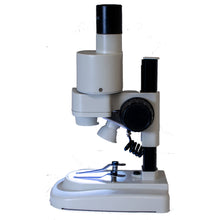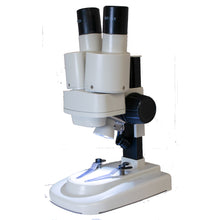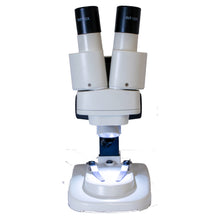Pickup available from Quicktest (WD18 8JA)
Email us
or call on 01923-220206 for appointment.
Summary
This is a 'small' microscope because it's only 8½ tall (most microscopes are 12 to 15 inches tall) and it's made of plastic and it's small and lightweight enough to carry in a bag. But it's not a pocket microscope. And it's not a toy. It's from the same manufacturers who make of our full-size professional microscopes, with large wide-field (WF) eyepieces.
Use it instead of a loupe, the quality is better than any 20X loupe and, being stereo, it's so easy to focus and to use. In fact, I would say: if you want a 20X magnifier and want the best possible quality, don't even think of buying a loupe, this is better (unless, of course, you really do need to carry it in your pocket).
Detail
Size: 8½ X 4 X 5½ inches
Weight: 500g
Light: powered by 2 X AA batteries.
As a laboratory microscope - definitely not, but as an alternative to the very best jewellers loupe, absolutely! The stereo view and the quality of the lenses make this perfect for inspecting stamps and coins, the grain in prints and photos, the composition of fabrics... In quality it is better than the best (Zeiss) loupes (but, of course, it is not pocket-size).
QUESTIONS & ANSWERS
Ask a Question-
Hi, would this be sufficient for detecting the growth lines in gemstones to identify lab from natural? Also, can you see laser engraving on natural certified (ie GIA numbers) and lab grown diamonds? Or should I be considering a different microscope? Thank you.
Yes, powerful enough and good-enough quality for inclusions in gemstones (e.g. growth lines). But there’s no flexibility with lighting as with the better microscopes and, ideally, you should adjust the direction and intensity of the lighting.
Yes, powerful enough to read the laser-engraving on diamonds but there is no special stone-holder so you it will be fiddly to hold it in exactly the right position.
All this said – the quality is better than the best loupe and it’s extraordinarily good value for a microscope of this quality.







